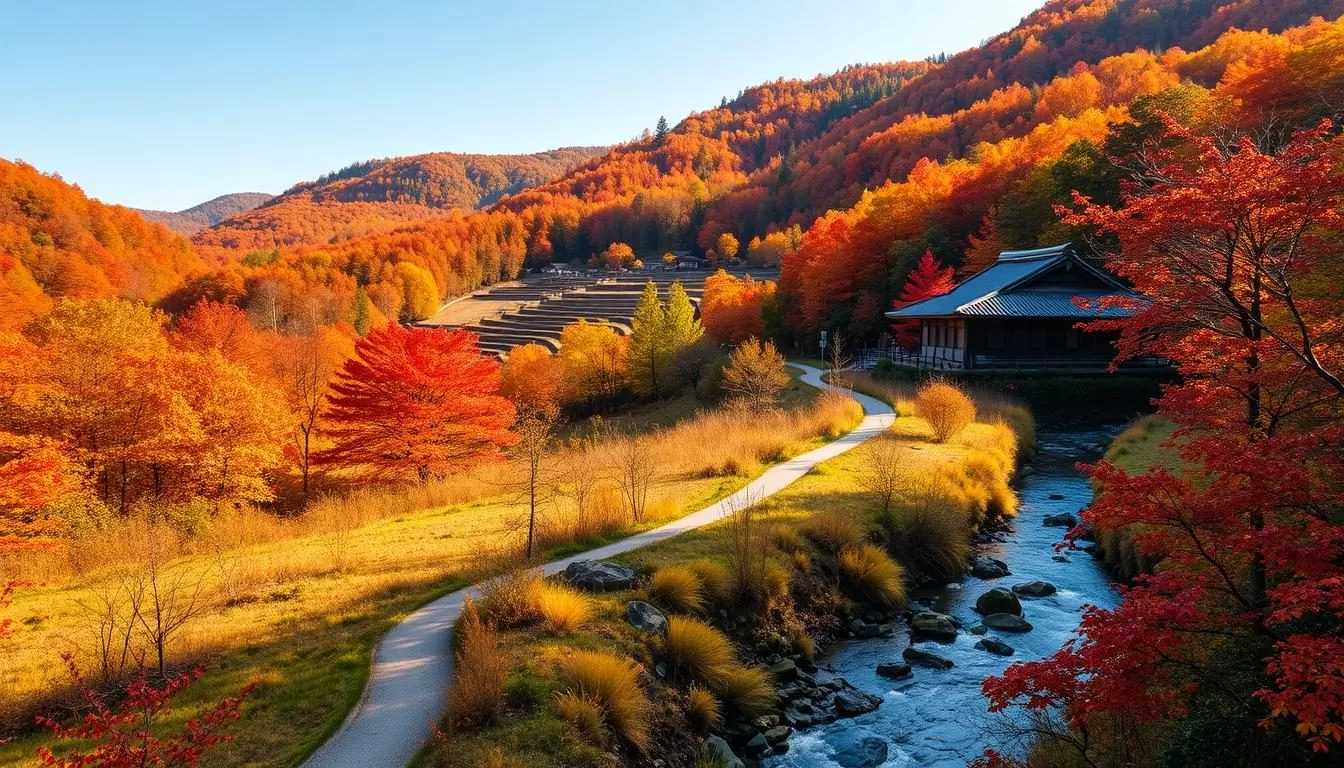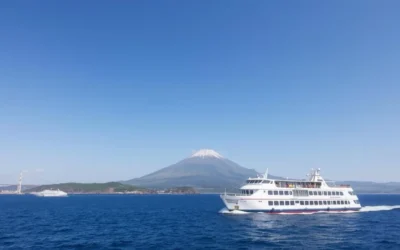✓ Accommodations✓ Flights✓ Rental Cars
Planning a trip to Gifu Prefecture requires understanding its distinct seasonal experiences. Located in the Hida region, Takayama offers a unique travel experience throughout the year.
Timing is everything when visiting this stunning region in central Japan. The weather and season significantly impact your travel experience. You’ll want to match your trip with your weather preferences, whether it’s spring’s cherry blossoms or winter’s snow-covered landscapes.
By understanding the seasonal highlights and weather patterns, you can plan a more enjoyable and memorable journey to this captivating Japanese destination.
Understanding Gifu Prefecture’s Unique Geography and Climate
The geography of Gifu Prefecture, situated within the Japanese Alps, plays a crucial role in shaping its climate and weather patterns. This unique location creates a diverse range of climates within the prefecture, making it an interesting destination for travelers.
Location in the Japanese Alps
Gifu Prefecture is strategically located in the heart of the Japanese Alps, a mountain range that stretches across central Japan. This location creates a unique climate zone that is different from coastal Japanese regions. The prefecture’s terrain is characterized by mountains and valleys, which significantly influence local weather conditions.
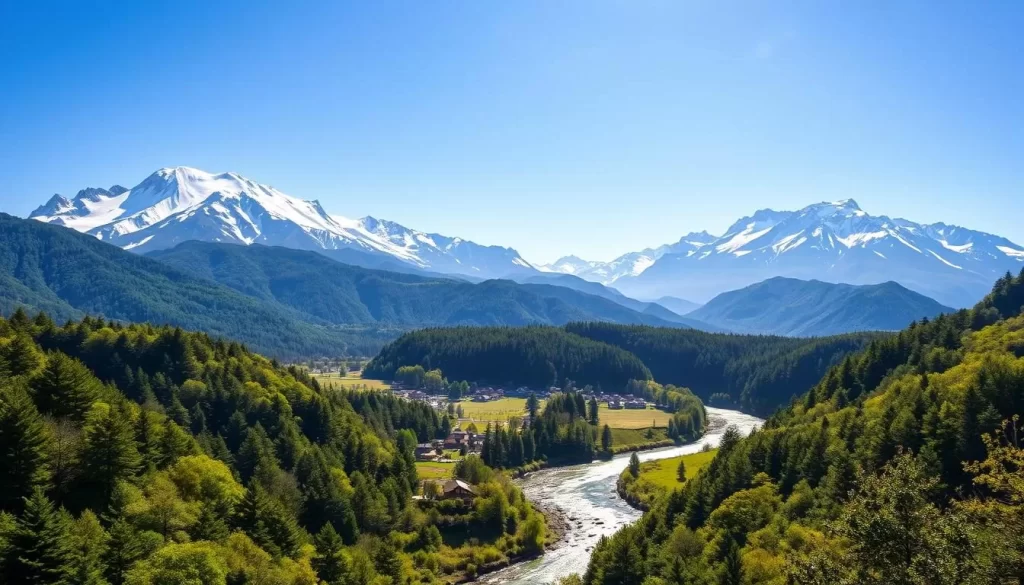
How Mountains Influence Weather Patterns
The mountainous terrain of Gifu dramatically influences local weather patterns, creating microclimates that can vary significantly even within short distances. Elevation changes across the prefecture result in temperature variations, with highland areas like Takayama experiencing cooler temperatures than lower-lying regions. The mountains act as natural barriers that affect precipitation patterns, creating distinct wet and dry seasons that you should consider when planning your visit at the right time.
Overview of Gifu’s Four Distinct Seasons
As you plan your trip to Gifu Prefecture, understanding the region’s four distinct seasons is crucial. Gifu Prefecture experiences a temperate climate with significant variations throughout the year, making it a fascinating destination for travelers.
Gifu’s weather patterns vary significantly across the four seasons. Here’s a breakdown:
- Spring (March-May) brings mild temperatures ranging from 10-20°C (50-68°F), with cherry blossoms and vibrant festivals.
- Summer (June-August) sees temperatures climbing to the high 20s°C (80s°F) with increased humidity.
- Fall (September-November) offers comfortable temperatures between 10-20°C (50-68°F) with minimal rainfall.
- Winter (December-February) transforms Gifu into a snowy wonderland with temperatures often below freezing.
Temperature Ranges Throughout the Year
The temperatures in Gifu Prefecture vary significantly across the year. In spring, Takayama has temperatures between 10°C to 20°C. Summer is warm, while fall is mild, and winter is cold, especially in higher elevations.
Precipitation Patterns and Considerations
Gifu experiences different precipitation patterns throughout the year. Summer is marked by occasional rainfall, particularly during the June rainy season. Fall generally has little rain, making it ideal for outdoor activities.
How Elevation Affects Weather Experiences
The varying elevations in Gifu Prefecture significantly impact the weather and overall experience. Mountain areas are cooler than valley regions, regardless of the time of year. Understanding this will help you plan your activities and packing accordingly.
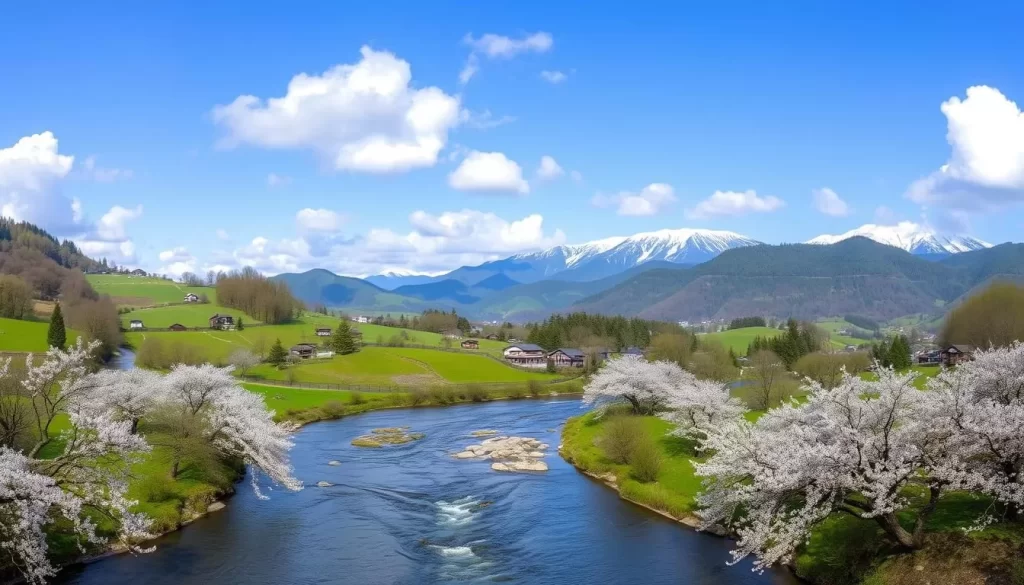
Spring in Gifu Prefecture (March-May)
Experience the enchanting beauty of Gifu Prefecture during spring, with its breathtaking cherry blossoms. As the landscape awakens, you’ll be treated to a vibrant display of colors and a plethora of cultural events.
Cherry Blossom Season: Timing and Best Viewing Spots
Cherry blossom season in Gifu typically runs from late March to mid-April. The exact timing varies by location and elevation within the prefecture. You’ll discover stunning viewing spots throughout Gifu, including the historic districts of Takayama and riverside locations where blossoms create beautiful reflections.
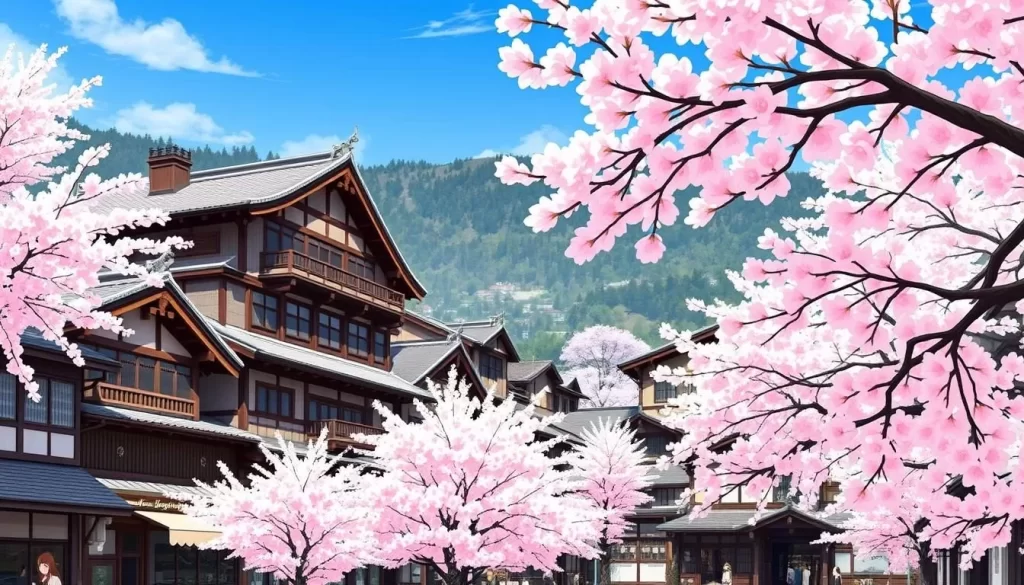
Spring Festivals and Cultural Events
Spring brings numerous cultural events and festivals celebrating the cherry blossom season. You’ll have the opportunity to experience authentic Japanese traditions, including traditional dances, food stalls, and local crafts.
Weather Conditions and What to Pack
Spring weather in Gifu is generally mild and pleasant, with temperatures ranging from 10-20°C (50-68°F). You’ll need to pack layers for your visit, as mornings and evenings can still be cool, while afternoons warm up considerably.
The Takayama Spring Festival: A Cultural Highlight
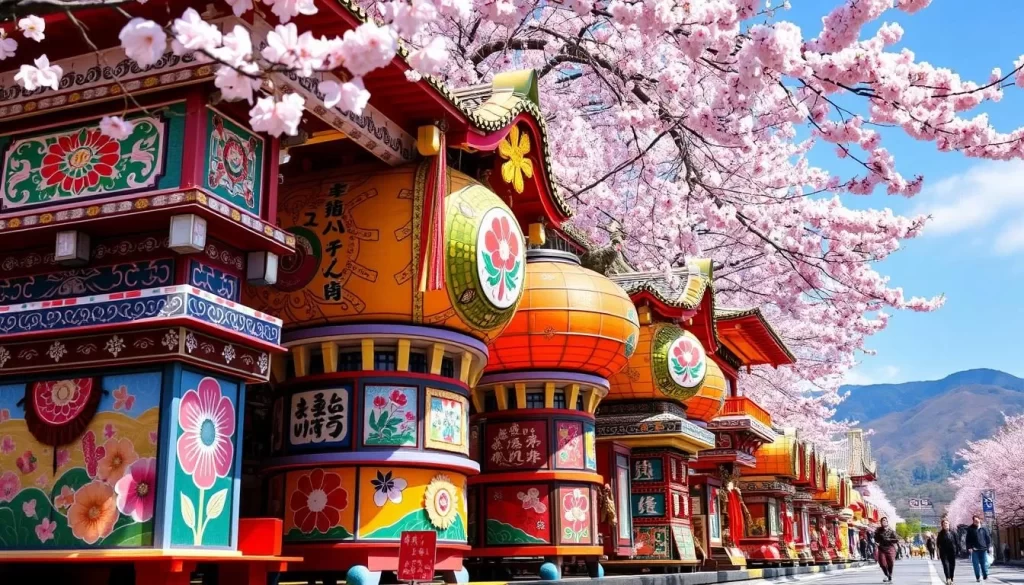
As spring awakens in Gifu Prefecture, the Takayama Spring Festival bursts into life, showcasing the region’s deep-rooted traditions. This festival, known as Sanno Matsuri, is one of Japan’s most revered traditional events, celebrated annually on April 14-15 at Hie Shrine.
Festival History and Significance
The Takayama Spring Festival has a rich history spanning over 400 years, honoring the arrival of spring and praying for a bountiful harvest. It’s a time when the community comes together to celebrate the season with vibrant festivities that reflect the city’s cultural heritage.
Elaborate Festival Floats and Performances
The festival is renowned for its stunning floats (yatai), which are masterpieces of traditional craftsmanship, featuring intricate carvings, metalwork, and decorative elements. The event also includes traditional music performances, puppet shows (karakuri), and ceremonial processions that animate the streets of Takayama.
Tips for Attending and Best Viewing Spots
To make the most of your visit, plan to arrive early to secure a good viewing spot, and consider booking your accommodations well in advance, as the festival attracts a large crowd. The best viewing spots are typically along the festival route, particularly around Hie Shrine.
Experiencing the Takayama Spring Festival offers a unique glimpse into Gifu’s cultural heritage and the significance of seasonal celebrations in Japanese culture. It’s an event that beautifully blends tradition with festivity, creating an unforgettable experience for visitors.
Summer in Gifu Prefecture (June-August)
Summer in Gifu Prefecture brings a unique blend of heat, humidity, and cultural festivities. As you plan your trip during this time, it’s essential to understand what to expect from the weather and how to make the most of your visit.
Managing the Heat and Humidity
Gifu’s summer is known for its sweltering heat, with daytime temperatures often reaching the high 20s Celsius (around 80-90 Fahrenheit). The high humidity makes the air feel even warmer. To manage the heat, locals use traditional cooling methods, including seasonal foods and cultural practices that you can adopt during your visit.
Summer Festivals and Cultural Events
Summer is a vibrant time in Gifu, with numerous festivals taking place throughout the prefecture. These local matsuri feature traditional music, dance performances, and spectacular fireworks displays, offering a glimpse into the region’s rich cultural heritage. You can experience the energetic festival atmosphere that characterizes Japanese summer.
Outdoor Activities and Natural Attractions
Despite the heat, summer is an excellent time for outdoor activities like hiking in the cooler mountain areas of the Japanese Alps, river rafting, and exploring natural swimming holes. The lush summer greenery transforms Gifu’s landscapes, with verdant forests, rushing waterfalls, and alpine meadows offering spectacular natural attractions.
| Activity | Location | Best Time |
|---|---|---|
| Hiking | Japanese Alps | Early morning or late evening |
| River Rafting | Rivers in Gifu | June to August |
| Exploring Natural Swimming Holes | Mountain areas | July to September |
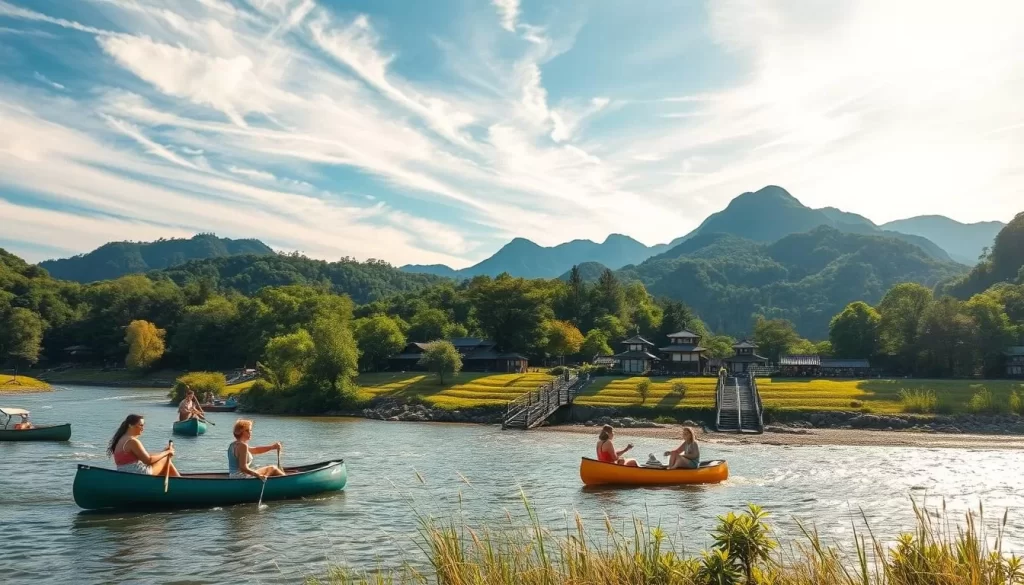
Gifu Prefecture, Japan: Best Months for a Weather-Savvy Trip
Gifu Prefecture’s diverse climate means that the best time to visit depends on your preferences and activities. Understanding the optimal weather windows can significantly enhance your travel experience.
Optimal Weather Windows for Different Activities
The best time to visit Gifu Prefecture varies based on the activities you have planned. For outdoor enthusiasts, spring (April-May) and fall (October-November) are ideal, offering mild temperatures and stunning natural beauty. If you’re interested in winter sports, December through February provides excellent snow conditions, particularly in the mountainous regions.
- Spring: Cherry blossoms and comfortable temperatures
- Fall: Vibrant autumn foliage
- Winter: Snow sports and winter landscapes
Avoiding Typhoon Season and Rainy Periods
To avoid disruptions to your outdoor plans, it’s crucial to steer clear of Gifu’s typhoon season (typically August-September) and rainy season (usually June). These periods can significantly impact your ability to enjoy the prefecture’s natural attractions.
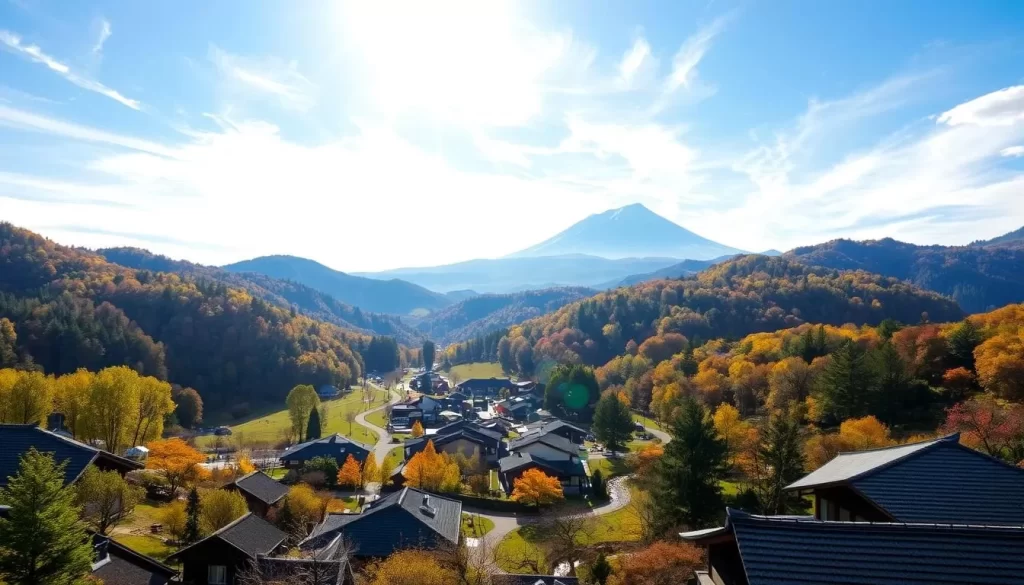
Balancing Weather Preferences with Crowd Levels
While the most pleasant weather periods often coincide with peak tourist seasons, being aware of crowd levels can help you plan a more enjoyable trip. For a more serene experience, consider visiting during the shoulder season, when the weather is still favorable but the crowds are smaller.
By identifying your personal weather preferences and priority activities, you can determine the best time to visit Gifu Prefecture, ensuring a memorable and enjoyable trip.
Fall in Gifu Prefecture (September-November)
The fall season brings a unique blend of natural beauty and cultural richness to Gifu Prefecture. As the summer heat dissipates, the region transforms into a vibrant tapestry of autumn colors, creating an ideal setting for outdoor adventures and cultural exploration.
Autumn Foliage: Peak Times and Viewing Locations
Gifu Prefecture’s autumn foliage is a spectacular display of reds, oranges, and golds, typically peaking from late September through November. The foliage season progresses from higher elevations to lower areas, with peak viewing times varying by location. You’ll find the best autumn viewing spots throughout Gifu, including historic temples, riverside walks, and mountain viewpoints that showcase the fall colors against traditional Japanese architecture.
Fall Festivals and Cultural Experiences
The fall season in Gifu is not just about the foliage; it’s also a time for cultural experiences. You’ll enjoy harvest festivals, traditional food events featuring seasonal specialties, and artistic celebrations that highlight the region’s rich cultural heritage. These events offer a unique glimpse into the local culture and are a great way to experience the community’s spirit.
Weather Conditions and What to Pack
Fall weather in Gifu is generally stable and pleasant, with comfortable temperatures ranging from 10-20°C (50-68°F) and minimal rainfall. However, it’s essential to pack layers for your visit, as days can be warm while evenings cool down significantly, especially in higher elevation areas.
The Takayama Autumn Festival: A Seasonal Treasure
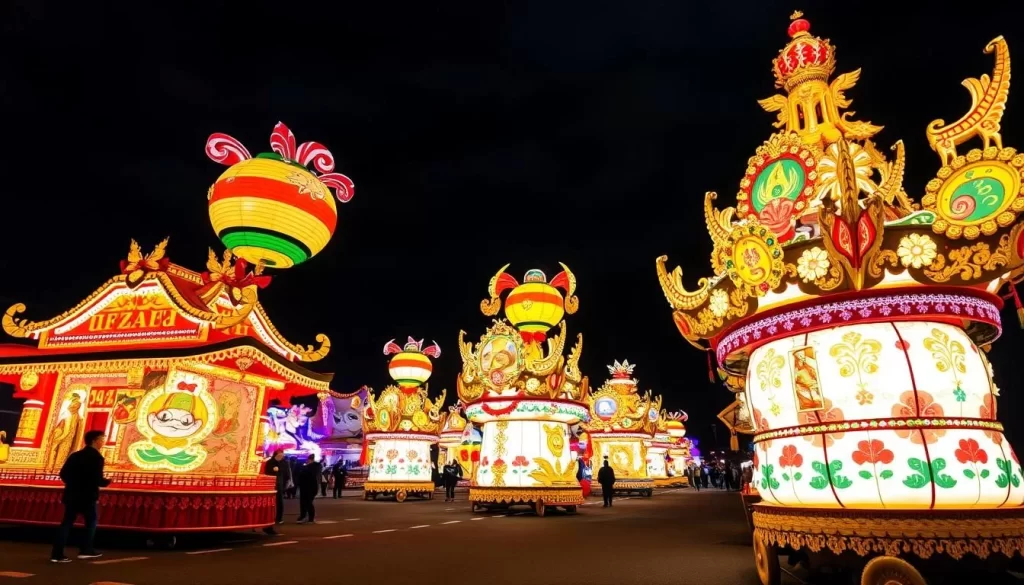
As autumn arrives in Gifu Prefecture, the town of Takayama comes alive with its famous Autumn Festival, a true cultural treasure. The Takayama Autumn Festival, also known as Hachiman Matsuri, is held annually on October 9-10 at Sakurayama Hachiman Shrine.
Festival Traditions and Cultural Significance
The festival has a rich history spanning over 350 years, celebrating the autumn harvest while honoring local deities. It showcases Takayama’s deep cultural traditions and community spirit, providing a unique insight into the region’s heritage.
Festival Floats and Night Illuminations
The festival features elaborate yatai (festival floats) adorned with intricate carvings, gold leaf decorations, and mechanical puppets (karakuri) that perform on the floats. The evening processions are particularly magical, with lanterns illuminating the floats as they parade through Takayama’s historic streets.
Planning Your Visit During the Festival
To experience the Takayama Autumn Festival, it’s essential to plan ahead. Accommodations in Takayama book up months in advance, and prices increase significantly during the festival period. You should also be prepared for the crowds and make the most of your visit by arriving early or exploring the surrounding areas.
The festival attracts both domestic and international visitors, creating a vibrant cultural exchange while maintaining authentic traditional elements. By experiencing the Takayama Autumn Festival, you’ll gain insights into Japanese cultural values, craftsmanship, and the importance of seasonal celebrations in rural Japan.
Winter in Gifu Prefecture (December-February)
Experience the magic of winter in Gifu Prefecture, where snow-covered landscapes await. You’ll discover a serene and picturesque environment, perfect for a variety of winter activities.
Snowfall Patterns and Winter Landscapes
Gifu Prefecture is blanketed with snow during the winter months, creating a beautiful snow-covered landscape. The temperatures typically range from -5°C to 5°C (23-41°F) in lower elevations, while mountain areas can drop well below freezing.
Winter Sports and Activities
The prefecture offers excellent opportunities for winter sports, including skiing and snowboarding at renowned resorts such as Dynaland, Washigatake, and Takasu Snow Park. These resorts cater to all skill levels, ensuring an enjoyable experience for everyone.

Beyond skiing, you can enjoy snowshoeing through ancient forests, winter wildlife viewing, and relaxing in outdoor hot springs surrounded by snow. These activities make the winter season in Gifu Prefecture a unique and memorable experience.
Winter Illuminations and Seasonal Events
The season brings special illumination events throughout Gifu, with light displays enhancing the snowy landscapes and creating magical evening experiences. These events add to the charm of the winter weather, making it a wonderful time to visit.
Shirakawa-go in Winter: A Snow-Covered Wonderland
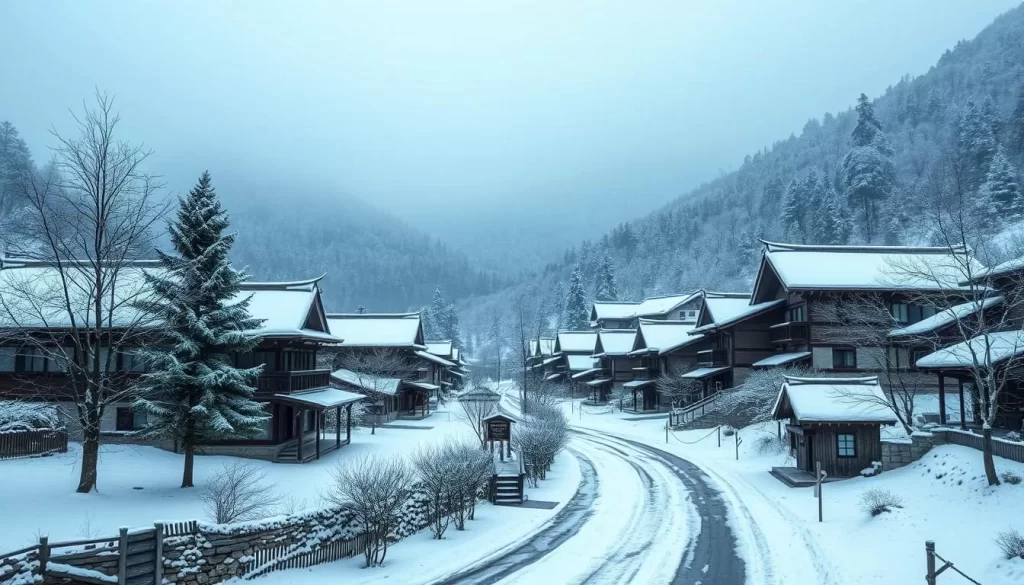
Experience the enchanting beauty of Shirakawa-go in winter, a UNESCO World Heritage Site transformed into a snow-covered wonderland. The village’s traditional gassho-zukuri farmhouses, with their steep, thatched roofs designed to withstand heavy snowfall, become a breathtaking sight against the pristine white landscape.
UNESCO World Heritage Site Under Snow
The snow-covered rooftops and the surrounding mountains create a serene and picturesque atmosphere, making Shirakawa-go a perfect winter destination. You’ll be transported to a fairy-tale setting as you explore the village’s historic houses and streets.
The Famous Winter Light-Up Events
One of the highlights of visiting Shirakawa-go in winter is the famous Winter Light-Up events, held on select evenings in January and February. The entire village is illuminated against the snow, creating a magical winter wonderland that offers unforgettable photo opportunities.
Transportation and Accommodation Tips
To make the most of your visit, plan ahead for transportation and accommodation. Regular bus services from Takayama continue throughout winter, but mountain roads can be affected by snow conditions. Staying overnight in one of Shirakawa-go’s farmhouse accommodations offers the most immersive winter experience, allowing you to enjoy the village after day-trippers have departed.
Practical Travel Tips for Weather-Savvy Visitors
A weather-savvy approach to traveling in Gifu can greatly enhance your overall experience. To make the most of your trip, it’s crucial to be prepared for the local weather conditions.
Essential Packing Lists for Each Season
Packing strategically for your Gifu trip is vital, as the season will greatly impact your travel experience. For summer, bring lightweight, breathable clothing, while winter requires warm, waterproof layers. Spring and fall call for versatile, layerable pieces.
Regardless of when you visit, comfortable walking shoes are a must, as Gifu’s beautiful attractions often involve significant walking on uneven surfaces.
Transportation Considerations During Different Seasons
The time of year affects transportation options in Gifu. Some mountain roads and passes may close during heavy winter snowfall, requiring alternative routes or transportation methods. The JR Takayama Line operates year-round but may experience delays during severe weather, so it’s advisable to build flexibility into your travel schedule.
Accommodation Recommendations Based on Weather
Your trip to Gifu will benefit from choosing accommodations that reflect seasonal considerations. For winter stays, opt for traditional ryokans with proper heating, while summer visits call for properties with air conditioning. During festival times, choose locations near major attractions.
To ensure a smooth travel experience, consider packing accordingly and booking accommodations well in advance, especially during peak seasons.
Traditional Japanese Accommodations in Gifu
Gifu’s traditional ryokans and minshuku offer a glimpse into Japan’s rich cultural heritage. You’ll enhance your Gifu experience by staying in a traditional ryokan, where seasonal elements are incorporated into everything from room decorations to meals.
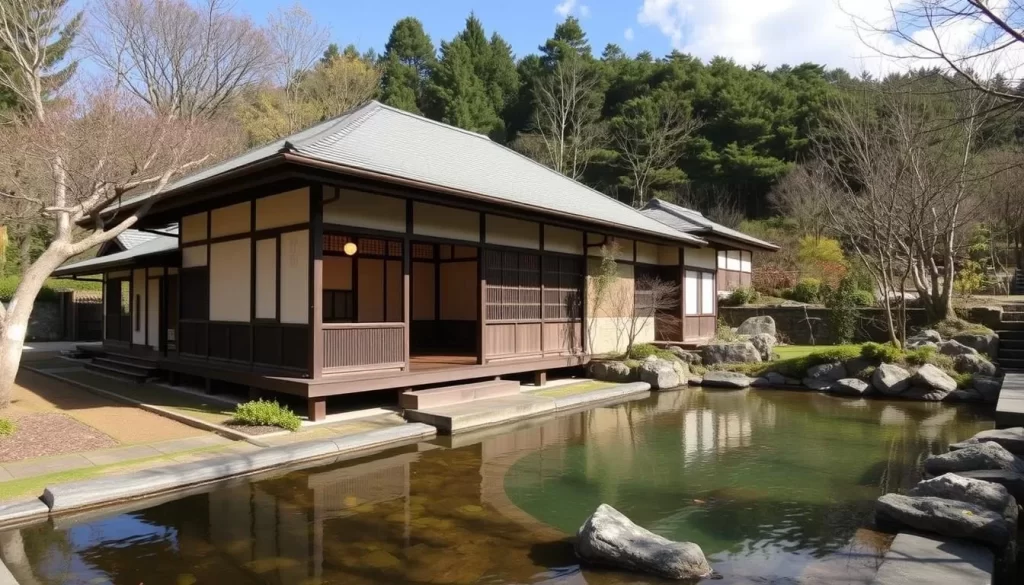
Experiencing Ryokans and Their Seasonal Offerings
Ryokans offer a deep cultural immersion with tatami mat floors, futon bedding, kaiseki multi-course meals featuring seasonal ingredients, and attentive hospitality that varies with the seasons. You’ll experience the essence of Japanese culture through these traditional inns.
Hot Springs (Onsen) Experiences Throughout the Year
Gifu Prefecture is renowned for its variety of hot springs, with each offering unique mineral compositions and health benefits that can be enjoyed year-round. Winter is particularly magical for hot springs experiences, as you can soak in steaming outdoor baths while surrounded by snow.
Booking Tips and Seasonal Availability
Booking traditional accommodations requires advance planning, especially during peak seasons when the most sought-after ryokans can be reserved months ahead. Prices for accommodations fluctuate significantly throughout the year, with premium rates during cherry blossom season, autumn foliage, and major festivals.
Conclusion
Gifu Prefecture is a year-round destination, with every season bringing its own charm. Whether you’re drawn to the vibrant cherry blossoms of spring or the serene snowy landscapes of winter, your ideal time to visit will depend on your personal preferences for weather and activities.
You can now make an informed decision about when to plan your trip to Japan based on Gifu’s seasonal highlights. By timing your visit strategically, you’ll maximize your enjoyment of Gifu’s natural beauty and cultural offerings.
With a weather-savvy approach, you’ll be prepared for any time of year, ensuring a memorable experience in this beautiful region of Japan.
The above is subject to change.
Check back often to TRAVEL.COM for the latest travel tips and deals.
